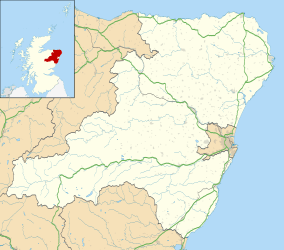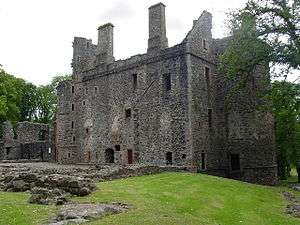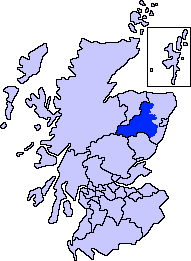Huntly Castle
Huntly Castle is a ruined castle in Huntly in Aberdeenshire, Scotland. It was the ancestral home of the chief of Clan Gordon, Earl of Huntly.
| Huntly Castle | |
|---|---|
| Huntly, Aberdeenshire | |
 Huntly Castle | |
 Huntly Castle | |
| Coordinates | 57.45488°N 2.78117°W |
| Type | L-plan tower house |
| Site information | |
| Controlled by | Clan Gordon |
| Site history | |
| Built | 12th century |
| Built by | Clan Gordon |
History
Architecturally the L plan castle consists of a well-preserved five-storey tower with an adjoining great hall and supporting buildings. Areas of the original ornate facade and interior stonework remain. A mound in the grounds of the castle is all that remains of an earlier 12th century motte. Originally named Strathbogie, the castle was granted to Sir Adam Gordon of Huntly in the 14th century. King Robert the Bruce was a guest of the castle in 1307 prior to his defeat of the Earl of Buchan.
It was fired in 1452 by a force under the command of Archibald Douglas, Earl of Moray. In 1449 the king was at war with the powerful Black Douglases, the Gordons stood on the king's side and, with their men involved in the south of the country, the Earl of Moray, a brother of the Earl of Douglas, took the opportunity to sack the Gordon lands, setting Huntly Castle ablaze. The Gordons returned and quickly destroyed their enemies.
Although the castle was burned to the ground, a grander castle was built in its place. In 1496, the pretender to the English throne, Perkin Warbeck, was married to Lady Catherine Gordon the daughter of George Gordon, 2nd Earl of Huntly, witnessed by King James IV of Scotland at Edinburgh. James IV came to Huntly in October 1501 and gave gifts of money to the stonemasons working on the castle. In October 1503, James IV came again and played in a shooting contest at a "prop", and he came back again in the following October. These visits were part of his annual pilgrimage to the shrine of Saint Duthac at Tain.[1]
William MacKintosh was executed on 23 August 1550 at Castle Strathbogie.

Wings were added to the castle in the 16th and 17th centuries. The English diplomat Thomas Randolph stayed two nights in September 1562, and wrote that the castle was "fayer, beste furnishede of anye howse that I have seen in thys countrie."[2] George Gordon, 4th Earl of Huntly died after the Battle of Corrichie, and the castle was garrisoned for Mary, Queen of Scots by Charles Crawfurd and twenty soldiers. Furnishings including beds and 45 tapestries were carted to Aberdeen and shipped in barrels to Edinburgh for the royal collection and refurbishment by Servais de Condé.[3]
A fatal football match
An eyewitness description of the death of George Gordon, 5th Earl of Huntly in 1576, compiled by Richard Bannatyne gives some details of how the castle was used. The Earl suffered a stroke, or a collapse caused by food-poisoning, while playing football outside the Castle on the Green. He was taken through the outer-gate to his bedchamber in the round tower of the palace block, which was then called the "New Warke of Strathbogie." The Earl's bedchamber was adjacent to his "Grit Chalmer", the Great Chamber. After the Earl died, his body was laid out in the "Chamber of Dais", another name for the Great Chamber, and his valuables were secured in the bedchamber. After the Earl's steward left the Castle a number of alleged supernatural events occurred beginning with the sudden collapse of one of the servants in the "Laich Chalmer", Low Chamber. This "Laich Chalmer" was in another part of the castle, under a stair opposite the "Auld Hall." On the following day a servant went up to the Gallery at the top of the "New Warke" where spices (which were precious) were stored. This servant and two companions also collapsed and when revived complained of feeling cold. After the Earl's body was embalmed and taken to the chapel, his brother sat on a bench in the Hall by the Great Chamber door, and heard unexplained sounds from the chamber. It was said that "there is not a live thing bigger than a mouse may enter in that chamber with the door locked."[4]


James VI slights the castle
James VI of Scotland arrived on 26 April 1589 after spending a night at Kintore. The Earl of Huntly had fled to the mountains, stripping the countryside and emptying the house of furniture. James brought 100 workmen to demolish the castle. Huntly sent the king an offer to spare the house and surrendered.[5] In July 1594 Huntly was overseeing the building of a new hall and gallery.[6] Following the battle of Glenlivet, James VI came with workman again and his master of works William Schaw, and blew up the old tower on 29 October 1594.[7] David Foulis wrote to Anthony Bacon that Henrietta Stewart, Countess of Huntly, watched the demolition and was not allowed to have an audience with the king to plead her case.[8]
Restored for a Marquess
The restored façade of the main block was carved with the names and titles of the marquess, "George Gordon" and his wife, "Henrietta Stewart" who was a favourite of the queen, Anne of Denmark.[9]
In 1640 the Castle was occupied by the Scottish Covenantor army under Major-General Robert Monro (d. 1680). James Gordon Parson of Rothiemay tells us how the house "was preserved from being rifled or defaced, except some emblems and imagery, which looked somewhat popish and superstitious lycke; and therefore, by the industry of one captain James Wallace (one of Munro's foote captaines) were hewd and brocke doune off the frontispiece of the house; but all the rest of the frontispiece containing Huntly's scutcheon, etc, was left untouched, as it stands to this daye."
Captured in October 1644, the castle was briefly held by James Graham, 1st Marquess of Montrose against the Duke of Argyll. In 1647 it was gallantly defended against General David Leslie by Lord Charles Gordon, but its 'Irish' garrison was starved into surrender. Savage treatment was meted out, for the men were hanged and their officers beheaded. In December of the same year the Marquess of Huntly himself was captured and on his way to execution at Edinburgh was detained, by a refinement of cruelty, in his own mansion. His escort were shot against its walls. An inventory made by the garrison shows the state rooms were still fully furnished including the earl's 'chapel bed'.[10] In 1650 Charles II visited briefly on his way to the Battle of Worcester, defeat and exile. The Civil War brought an end to the Gordon of Huntly family's long occupation of the castle.
In 1689, during the first Jacobite rising, the castle was briefly the headquarters for Viscount Dundee and his Jacobite army, at the end of April, just after the start of the revolt. However, by the early eighteenth century the castle was already in decay and providing material for predatory house builders in the village. In 1746, during a later Jacobite rising, it was occupied by British government troops. Thereafter, it became a common quarry until a groundswell of antiquarian sentiment in the 19th century came to the rescue of the noble pile.
Huntly Castle remained under the ownership of the Clan Gordon until 1923. Today, the remains of the castle are cared for by Historic Environment Scotland as a scheduled monument.[11]
Pure Strength I, a major international strongman competition, was held on the grounds of Huntly Castle in 1987. The winner of the contest was Jón Páll Sigmarsson of Iceland.[12]
| Wikimedia Commons has media related to Huntly Castle. |
References
- Accounts Lord High Treasurer of Scotland, vol.2 (1900), p.xlix-l, 124, 401, 464: for "prop" see Dictionary of the Older Scottish Tongue
- CSP. Foreign, Elizabeth, vol. 5 (London, 1867), nos. 648, 823: CSP. Scotland, vol. 1 (Edinburgh, 1898), p. 652.
- Michael Pearce, '"Beds of 'Chapel" form in sixteenth-century Scottish inventories: the worst sort of beds', Regional Furniture, vol. 27 (2013), pp. 78-91: Accounts of the Treasurer, vol. 11, p. 214, 217.
- Pitcairn, Robert ed., Bannatyne's Memorials of the Transactions in Scotland (1834), 334-5: McKean, Charles, The Scottish Chateau (Sutton, 2001), 109.
- Calendar State Papers Scotland, vol. 10 (Edinburgh, 1936), pp. 51-2.
- Calendar State Papers Scotland, vol. 11 (Edinburgh, 1936), p. 375.
- Calendar State Papers Scotland, vol. 11 (Edinburgh, 1936), p. 470: Register of the Privy Council, vol. 5 (Edinburgh, 1882), pp. 185-6.
- Thomas Birch, Memoirs of the reign of Queen Elizabeth, vol. 1 (London, 1754), p. 192.
- Charles McKean, Scottish Chateau (Stroud, 2001), pp. 216-7.
- Michael Pearce, '"Beds of 'Chapel" form in sixteenth-century Scottish inventories: the worst sort of beds', Regional Furniture, vol. 27 (2013), pp. 84-5: Michael Pearce, Whispers from An Age Gone By', Historic Scotland Magazine, (Winter 2016), pp. 16-18: Maria Hayward, Stuart Style (Yale, 2020), p.p. 244-5.
- Historic Environment Scotland. "Huntly Castle (SM90165)". Retrieved 27 February 2019.
- "1987 Pure Strength Contest". strongestman.billhenderson.org.
External links
- Historic Environment Scotland: Visitor guide
- More photographs of Huntly Castle
- Engraving of Huntly Castle by James Fittler in the digitised copy of Scotia Depicta, or the antiquities, castles, public buildings, noblemen and gentlemen's seats, cities, towns and picturesque scenery of Scotland, 1804 at National Library of Scotland
- Video images and narration - Huntly Castle & Huntly Lodge
